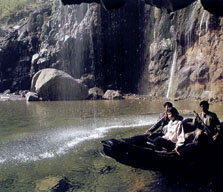
Having lived in south China for many years, I was eager to make a wintry journey to north China so I could appreciate the beauty of rigorous mountains swept by strong wind.
Among the best known mountains in north China are the Taihang Mountains and my journey around Taihang started from the famous Wangwu Mountain, which is to the south of Taihang Mountains and located in the city of Jiyuan of central China's Henan Province.
With its highest peak reaching 1,715 meters, Wangwu Mountain stands straight against the endless sky. To overlook the whole village from the mountain, we had to climb at least 10 kilometers along steep slopes.
After making our preparations, we put on heavy overcoats and set out by treading on the withered fallen leaves. On such a chilly day, all of us felt out of breath and were soon perspiring. We had to slow our pace, taking a little rest to catch our breath.
Four hours later, we arrived at the peak. But when we were told that it only took local villagers 40 minutes to climb to the top of the mountain, I felt quite ashamed.
At the top of the mountain, an altar abruptly appeared, an ancient place of sacrifice to Heaven. Now, it was being re-constructed to revive its past dignity. Surrounded by rosy rays of the setting sun, we looked far into the Yellow River and allowed ourselves to enter a fairytale world.
We stayed overnight in a watchtower close to the altar. At night, I was awakened by the piercing wind and burrowed under the quilt to escape the cold. A sleepless night!
At dawn, I climbed to the top of the watchtower and, in spite of the fierce gale, was delighted by the bright and colorful sunrise. In the morning sunshine, local villagers climbed up to the mountain, burnt incense and prayed.
Wenpanyu Gorge
We left the mountain top in the morning, then enjoyed some delicious food in the village and continued our journey to the eastern ridge of Taihang Mountains. We had a good time when passing through Qinyang and Bo'ai counties where we visited Xuangu Mountain, Qingtian River and Moon Mountain and came to the famous National Yuntai Scenic Spot composed of the scenery around Taihang Mountains in Xiuwu County.
Wide Yuntai Avenue led directly to the mountain. Hundreds of meters away from the mountain, we could hear the waterfall splashing onto the rocks below. Some of my friends walked close to the edge to see the cave behind the waterfall and got wet from the water spray.
With a length of one kilometer and a width of 10 meters, Wenpanyu Gorge was a marvellous place to enjoy the picturesque creations of nature. Because it was narrow and deep, the gorge was seldom influenced by the weather outside. Inside the gorge, the temperature of the deep pool remained at 10 degrees centigrade all year around and it has formed a special climate in the gorge, cool in summer and warm in winter.
In the centre of the Yuntai Scenic Spot is Zifang Lake reflecting the mountains and trees around it.
Guoliang Cave
Turning to the north, we came to Taihang Mountains in Huixian County. The local government has explored several scenic spots to develop tourism, among which the most attractive were Guoliang Cave and Bali Gully.
Mountains around the Guoliang Cave were composed of exposed red shale, which took on many different shapes. Local villagers cut a tunnel road through the mountain and named it Guoliang Cave. Years ago, villagers could only descend the mountain on a dangerous path, which was very inconvenient. Now the situation has totally changed. Guoliang Village is becoming a pearl of Taihang Mountains because of its unique scenery and stone buildings.
It happened to be Sunday when we arrived at Bali Gully. Urban tourists swarmed into this silent and deep crevice. We sat beside the crystal stream, eating corn porridge fried pancakes. All of us were in a happy mood.
Our last stop along the Taihang Mountains was in Linzhou City. In the 1970s, local people dug Hongqi Channel, which not only irrigated large stretches of farmland for villagers but also became a fascinating scenic spot. We took a small boat on the 150-kilometre-long river and went deep into Shibanyan Village, which is abundant in various kinds of marble.
In Linzhou City, we viewed a mountainous landscape that we could not see in urban areas. Wherever we went, we were amazed by the splendor of ridges, rocks and valleys.
(Shanghai Star March 17, 2005)
|

